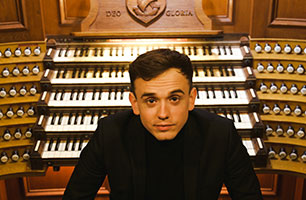The pages that we shall hear tonight have been composed for the most part in the last months of their creators’ lives, but this is not the only feature they have in common. Indeed, Mozart, Franck and Reubke were also both remarkable pianists and eminent organists.
Wolfgang Amadeus Mozart truly revered the pipe organ, and upon his return from Paris in 1779 was actually appointed Court organist at Salzburg Cathedral. It is for this particular town that he wrote his so-called Church Sonatas for strings and organ.
On June 18, 1791, he put the finishing touch to his famous Ave verum. In the same spirit, and on the same day in Baden, he wrote a small piece for a peculiar instrument which he simply called “Harmonica”. It was a row of crystal bowls activated by a pedal that you rubbed with a wet finger. This contraption perfected by Benjamin Franklin in 1761 had been used by the hypnotizer Franz Anton Mesmer. It was at his place that Mozart discovered it. This adagio as pure as it is concise sounds almost surreal when played on the most cristalline registers of the organ.
It is yet for another instrument that he wrote the Allegro und Andante für eine Orgelwalze. Count Joseph Deym von Stržitež, a larger-than-life character, owned a well-known cabinet of curiosities in Vienna. It contained a number of barrel instruments which played scores specially composed to his intention. It is for one of these quite large-size “automaton-organs” that Mozart wrote this triptych – in fact and Allegro, Andante and Allegro – with daring harmonies and a counterpoint nourished by Bach’s. A fascinated Beethoven copied this score, whose central portion sings passionately as in the most beautiful arias of The Magic Flute.
99 years later, we discover one of the major composers of his time, César Franck as he retires to Nemours for a few weeks of convalescence. At the top of a belated glory, he is contemplating a project of combining within sophisticated expressive forms Bach’s counterpoint and the memory of the great Romantic composers that he practices with his own hands. This is how transformations of Beethoven and Liszt as well as reminiscences of Canto can be found in Three Chorals, as well as in the beginning of the Third Choral which is reminiscent of the Prelude and Fugue in A minor, BWV 543.
The word “choral” here refers to a melody harmonised note for note which emerges as the piece unfolds, fertilising its development to finally reach a triumphant conclusion. The composer finalised the score in the autumn in Paris, before leaving this world. The Chorals are rightly considered as the musical testament of the composer who was kindly nicknamed Pater seraphicus. Before that, however, Thomas Ospital has us listen to a much earlier work: the Fantaisie en ut, written initially in the late 1850s and presented in its final version at the 1868 inauguration of the great organ of Notre-Dame de Paris. Franck wished for a grand architectural setting, although not ostentatious, for his instrument. A calm and serene introduction, a canon at the octave line doubled with a new theme, short transition followed by a long melody in D minor on the oboe part soon entering into a dialogue with the flute. And finally, a sensitive allusion to the very last moments of Beethoven’s Sonata Op.111 in a music piece that most discreetly fades away.
“Nobody is more intensely aware of how great the loss of your Julius represents for the arts than he who followed his noble, constant and talented progress in the last years,” Franz Liszt wrote to Julius Reubke’s father after the young composer’s death.
His life cut short in 1858 at only 24, Reubke was born twelve years after Franck. The son of a renowned pipe organ maker, a child prodigy, he wrote just at the end of childhood a splendid Scherzo for piano reminiscent of Chopin. Introduced to Liszt by Hans von Bülow, he was dazzled by this encounter, just like with César Franck ten years earlier. In the steps of the great Hungarian who was called “Mozart resuscitated” in his youth, Reubke aspired to write two great sonatas, one for the piano, which he produced in 1857 and the other one for the organ, completed on the year of his death. As a reminder, Liszt had composed the extraordinary Fantasy and fugue on Ad nos, in 1950, the richest work ever written at the time for the pipe organ. Seizing upon the tense climate of Psalm 94, Reubke made a one-piece score gathering the ramifications of a unique chromatic and sinuous theme which would also be used by Claude Debussy in two of his works (the String Quartet and The Fall of the House of Usher). As in the Troisième Choral by Franck, and maybe even more, the Reubke’s work moves out into limbo with extraordinary suggestive power until it blooms in an impressive climax.
This inspired programme presents the quintessential art of these composers – two of them still young – who were particularly touched by grace at the end of their lives intensely filled with yearnings for beauty.
Éric Lebrun



